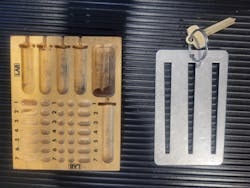Frank Best, a high-school teacher in Washington, created the small-format interchangeable core (SFIC).
His objectives were to create a “masterkey system” to eliminate the necessity of carrying a cumbersome key ring that contained a key for each door in a building and provide a convenient and inexpensive lock mechanism that could be removed and installed in seconds. And it all had to fit inside the dimensions of a mortise lock cylinder. He then spent the rest of his life inventing, refining and monetizing his products.
Best left behind quite a legacy, accumulating 58 patents for locks, keys and lock-related equipment. His company was acquired by dormakaba in 2017.
How It Works
The basis of the interchangeable core (IC) is the built-in dual locking mechanism. The IC operates the locking mechanism and enables rekeying through a control key. ICs don’t have to be masterkeyed, but every IC will have at least two keys: the operating (change) key for unlocking and the control key for removing the core.
“Control keys in an SFIC system are just like the other system keys but are cut to work the upper shear line,” says Dan Armstrong of SFIC Security Solutions in Fenton, Michigan. A standard cylinder has one shear line that operates the lock. An SFIC has two — one that operates the lock and one that retracts the control lug for releasing the core from the shell.
“So, besides the tumblers that control the lock cylinder’s opening function for the masterkeys and change key for that lock, each chamber in the lock will have tumblers combinated to retract the control lug,” Armstrong adds.
The markets for ICs are extensive, and most involve masterkey systems.
ICs have a strong presence in the commercial space. Dan Stewart, business development manager at dormakaba, says between 80-85% of all commercial buildings use ICs.
“In those buildings, if you can lock it, there is an interchangeable-core locking mechanism for it,” he says. Beyond the door, file cabinets, desk drawers, storage cabinets, key switches and padlocks are some of the applications for an IC.
The IC Toolbox
It takes the right tools to service ICs, Stewart says. These primarily include:
- Pinning kits for combinating cores.
- Key cutters for cutting keys for use with the IC.
- Capping blocks, ejector pins and various alignment wrenches used to install the core in a cylinder and ensure proper orientation and timing.
Other tools that are useful include Allen wrenches, screwdrivers, tweezers and magnifying glasses. (Some pin segments are pretty small.) Lubricants and graphite also can be useful as long as they’re used appropriately.
For me, servicing IC locks was different from servicing standard cylindrical locks. Standard rekeying doesn’t involve the critical tolerances typical of ICs. I typically would create ICs off-site in a clean, controlled environment working from masterkey charts.
My most vivid memories of rekeying “standard” cylindrical locks involve baking in a van as hot as an oven while working for an unhappy homeowner. On more than one occasion, it would be a repeat client, and I would be amazed to find only one chamber pinned by the last locksmith. That technician dumped the old pins and reinstalled pins into only one chamber.
Lock manufacturers strongly recommend using bottom pins that are manufactured of the same material as the original keys and cores. Brass bottom pins should be operated with brass keys and nickel silver bottom pins should be operated with nickel silver bottom pins. Similar materials will have even wear on the bottom pins and keys. Dissimilar materials will have uneven wear on the softer metals’ surface and result in core failure.
IC keys are cut to tight tolerances. The increment is only 0.0125 inches, and the IC has smaller diameter pins and cores constructed for the tighter tolerances. For this reason, it always is recommended that IC keys be originated, not duplicated. Duplicating and even originating different IC key-blade profiles when using rotary key machines can be problematic.
For this reason, using a dedicated keypunch machine can be the answer to originating IC keys. When I used to rekey retail banks, I used a PRO-LOK Blue Punch to work quickly and assure accuracy. Each Blue Punch machine had a vise jaw designed for the particular keyway you specified, which in my case was A2 keys.
In addition, the cutter is designed specifically for the origination procedure, having the correct flat and fixed depths and spacing. Standard spacing for an SFIC is 0.150 inches cut to cut.
Locksmith Ledger asked George Bertram, LAB’s director of sales and product development, what tools he recommends for locksmiths who sell, install and service IC cores. Bertram recommends the IC Kit specific to the application, Annex, Tweezer, LAB Capping Press (if necessary) and followers.
Capping Presses
Dedicated capping presses simplify capping ICs. The capping press controls the distance the cap can enter the core, which limits the ability to deform the cap. Capping presses are available that allow for single-chamber capping or the capping of six chambers at once.
Every lock system specifies the allowable height of the stack of wafers in a cylinder. For A2, it’s 23. Masterkeying software calculates the stack height, but human error can occur, and the stack height might exceed the specified number.
Sometimes I used to test each chamber with the master, control and change keys before capping. It wasn’t a 100% guarantee the pinning was correct, but it was pretty good, and if I made a mistake, it was faster to catch the mistake going chamber by chamber. More-proficient technicians might have their own process that works perfectly fine.
A1 Security Manufacturing’s Capsaver Press creates its own caps from a brass strip and seats them. This eliminates the necessity to place one cap over each chamber opening. Unfortunately, A1 is now out of business.
LAB’s IC Pro 150 is an all-in-one capping tool for SFIC cylinders that use the BEST-type keyway. The unit can accommodate any six- or seven-pin SFIC cylinder that has standard 0.150-inch spacing.
The location and depth of caps are preset at the factory. The tool uses standard LAB brass capping strips and replacement punch assembly.
More info: www.labpins.com
Key Gauges
Key gauges are stamped metal plates that have one or more tapering slots used to determine the depths of cuts in keys. To decode, insert a key blade into the larger end of the slot with the bottom of the blade above the numbers. Stop when the cut to be decoded is aligned centrally with the metal plate. Slide the key toward the smaller end until the portion of the blade remaining can’t slide further. Read the depth of the cut stamped into the tool.
IC key gauges are available in different configurations. Some have a single slot, while others have three slots for the A2, A3 and A4 systems.
To determine the pinning for A2 ICs, LAB developed its EASY WAY I.Core Pinning Slide Chart, which displays pin stacks for one pin chamber at a time.
The QU-I.C-KEY System from Interchangeable Core Lock Systems provides customized and fast masterkeying information for a single or a six- or seven-pin SFIC keying system. The QU-I.C-KEY pin segment calculator provides every pin segment calculation for a system through a color-coded system. The QU-I.C-LOAD tool holds the core and provides color-coded chamber identifiers that match the calculator for rapid pin tumbler loading. The QU-I.C-Test Tool allows the core to be tested before installing the spring retainer.
More info: www.iclsglobal.com
Loading and Dumping Blocks
Loading blocks and dumping blocks simplify combinating and emptying an IC’s pin tumblers. A dumping block is used to remove and keep the cap, spring and pin tumblers from each core chamber in the order in which they were removed. Dumping blocks can be used to unload one or more pin chambers at a time. Dumping blocks require an ejector pin to release the cap on each chamber. Some dumping blocks have a built-in decoding mechanism.
The stainless steel LAB Interchangeable Core Annex is a loading/capping block, dumping block and decoder in one. The Annex allows the user to dump the core pins, springs and caps from each chamber into a confined area. The pins can be decoded, and the control-key cut depths can be determined. The Core Annex comes with a code book, a capping tool to set the caps and an ejector tool to release the caps.
The PRO-LOK I/C Rekey, Decode & Dump Tool simplifies three functions into one easy-to-use tool. The chamber cap and retainer sleeve staking feature holds the key cylinder and provides a place to dump pins for decoding, dumping or rekeying. The tool includes a removable inspection plug, a chamber-cap staking plate, a sleeve retainer staking plate and holding knobs.
Optional tools sold separately include an ejector pin, staking pin and plug holder.
More info: www.pro-lok.com
.
Drill Jigs
Drill jigs are available for drilling ICs. Should you decide to drill, make sure the jig uses drills at the location and size of hole you want. The Peterson Manufacturing I-Core Drill jig for SFICs is designed to allow the core to be decoded without damaging the door hardware after it has been drilled and removed. The tool comes with complete instructions, drill bits and guides.
More info: www.thinkpeterson.com
Specialized Key Machines
PRO-LOK’s I-Core A2 Blue Punch key machine is a dedicated key-punch machine designed to provide factory-original keys at the speed of a duplicator. The Blue Punch is fast, accurate and easy to use. It’s set up at the factory to provide automatic spacing and depth.
The machine cuts A2 standard ICs, including BEST, Falcon and Arrow SFIC key sections A-R,TA-TE, W and Arrow 1A-4D. It will cut A3 and A4 with the purchase of an additional codebar.
Storage
Pinning high-security cylinders and securing side bars, sliders and security leg pins can cause real problems if parts are lost. The LockCaddy SFIC and LFIC trays are designed to keep these parts from being lost.
The tray stores and places bottom pins, top pins, caps and springs close to the SFIC core while pinning.
Meanwhile, LockCaddy’s GO-NO-GO tool is used to measure the proper stack height of an IC cylinder (23).
After you load a core, and before capping, you use the GO-NO-GO tool to measure the cylinders for the uniform required stack height.
Finally, the LockCaddy Carrier safely transports cylinders, cores, keys and tools at the shop, van and job site.
More info: www.lockcaddy.com
Tim O’Leary is an experienced security consultant and a regular contributor to Locksmith Ledger.






